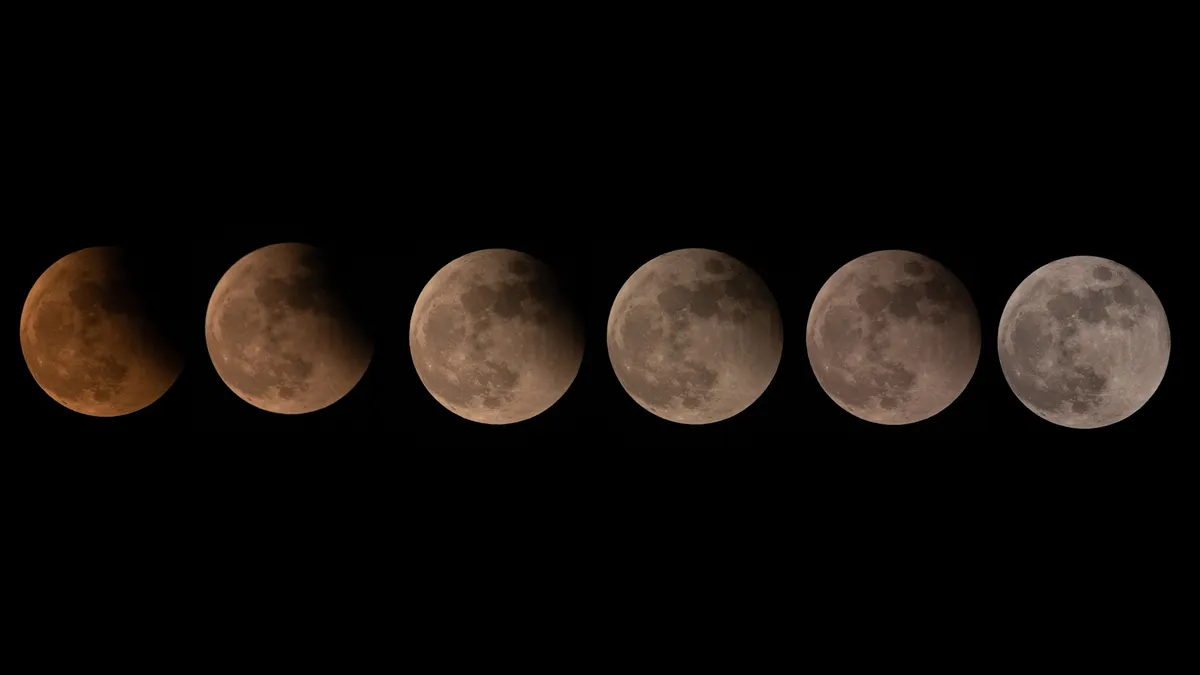On 18 September 2024 we'll be treated to a small but welcome partial lunar eclipse, and in this guide we'll show you how to photograph it.
The partial lunar eclipse occurs on the morning of 18 September, when a maximum of 3.5% of the Moon’s surface (8.5% of its diameter) will be covered by the darkest umbral part of Earth’s shadow.
Find out when the next eclipse is taking place

Colours in a lunar eclipse
A total lunar eclipse is a colourful affair.
The dark part of Earth’s inner shadow isn’t totally dark, but infilled with sunlight refracted through the thin ring of atmosphere at the edge of Earth.
The blue component is scattered, leaving predominantly reddish hues to infill the shadow.
Depending on things like the amount of cloud cover on Earth at the time of the eclipse, the shadow can appear a deep brownish colour, where the Moon almost disappears from view.
At the other end of the scale, the shadow colour can appear a coppery or even light golden-yellow colour. Typically it’s somewhere in between.

Total vs partial lunar eclipse
Photographs of totally eclipsed Moons maximise the beauty of this colour, but partial lunar eclipses are a different matter.
The reason why a total lunar eclipse looks so colourful in photographs is that the camera can be optimally set to capture the dark shadow-covered Moon with one exposure.
When the eclipse is partial, you’re dealing with both the umbral shadow and the bright non-eclipsed lunar surface as well.
Here, exposures set to show the bright surface darken the umbral shadow so much it’ll simply look black.
In order to show its colour, the bright portion typically needs to be sacrificed.

Before continuing, there’s something to clarify first. The brighter portion of the Moon’s surface is also eclipsed during the maximum part of a partial lunar eclipse, being covered by Earth’s much weaker penumbral shadow.
This is really subtle and hard to detect with the naked eye.
It appears more like a gentle shading, darkest adjacent to the edge of the umbral shadow and probably not dark enough to allow you to expose correctly for the entire Moon and preserve the umbral shadow’s colour properly.
Interestingly, it’s not just the umbral shadow that holds the colour either.
That darkest bit of the penumbra can be pretty colourful too, sometimes revealed as bands of yellow or grey-blue, if processed with care.

Tips and techniques
The brute force technique to pull out umbral colour is to expose for the dark shadow on its own, ignoring the fact that the bright surface will over-expose.
Best of all, take a set of exposures starting from correctly exposed through to having the bright surface over-exposed and the shadow’s colour revealed.
This will then give you enough images to work with which can be recombined in a manner that produces a dynamic range not possible with either your camera or, for that matter, your eye.
The very small nature of this partial lunar eclipse makes grabbing the colour that bit harder, but it should be possible.
For those with less image scale to hand – for example, if you’re using a smartphone camera – the low altitude of the event should make it possible to include interesting foreground objects into the shot as well.
Done well, this can really add a dynamic element to the eclipse, even if you don’t capture the colour.
Equipment
- DSLR or equivalent camera
- Telephoto lens or telescope on a driven equatorial mount
Step-by-step
Step 1

Use an imaging setup that records a tangible Moon disc; around 200–1,000mm is ideal. Focus using the Moon’s edge, select a lowish ISO (200–400) and stop down to around f/8, if using a lens. At 01:30 BST (00:30 UT), take a test exposure of the uneclipsed Moon at 1/500s. Adjust the exposure to optimise the histogram.
Step 2

Note your exposure settings for the normal surface. Shoot at, say, 10-minute intervals as the penumbral shadow creeps across the Moon. Avoid adjusting settings until 03:12 BST (02:12 UT), when the umbral shadow appears. Keep taking normal surface shots as well as longer exposures to reveal detail in the umbra.
Step 3

When done, download and examine your images. You’re looking for a good pair of images close to the peak of the eclipse at 03:44 BST (02:44 UT), one correctly exposed for the surface and one optimised for the umbral shadow that shows detail within the shadow region. Open those images in a layer-based editor.
Step 4

We need the luminance elements from each shot. One way is to simply convert to black and white. Another is to change the images to ‘Lab’ mode, view the channels and copy the lightness data. Paste the luminance versions from both images into a new RGB image as separate layers, surface exposure on top.
Step 5

Align the layers. Select the umbral shadow by drawing a circular selection around the Moon, then a subtraction selection for the normal surface area. Copy and paste as a layer mask for the surface layer. Blur the mask to blend the surface and umbra luminance. Adjust brightness, contrast and curves for both layers.
Step 6

Once you have achieved a natural blend, merge the layers to form a master luminance. Reopen the umbra-exposed image, copy and paste the merged luminance as a new layer in the umbra image and set its blend mode to ‘Luminance’. Tweak the saturation of the underlying umbra exposure image to suit.
If you observe or photograph the 18 September 2024 partial lunar eclipse, share your experience and images with us by emailing contactus@skyatnightmagazine.com

